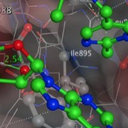A case of nephrogenic diabetes insipidus with a novel missense mutation in the AVPR2 gene.
Keywords
Abstract
We describe a pediatric case of nephrogenic diabetes insipidus (NDI) with a novel missense mutation in the arginine vasopressin receptor 2 (AVPR2) gene. The patient, a 3-year-old boy, had polyuria (4357 ml/day, 7230 ml/m(2)/day) and polydipsia. Water deprivation testing demonstrated no decrease of urine volume, and urinary volume did not respond to subcutaneous injection of 0.1 U/kg pitressin. Molecular genetic analysis demonstrated that the patient had an AVPR2 missense mutation involving substitution of phenylalanine for tyrosine at position 205 (Y205F). It was also found that the patient's mother was heterozygous for this Y205F mutation. Analysis of the intermolecular interaction of the Tyr-205 hydrogen group by molecular modeling showed that Tyr-205 was located in transmembrane domain (TM) 5, and that its hydroxy group formed a hydrogen bond with Leu-169 main-chain =O located in TM 4. The mutation of Tyr-205 to phenylalanine would cause loss of this hydrogen bond and decrease or change the interaction between these TM coils, thus affecting the ability of AVP to bind to the receptor. According to this molecular model of AVPR2, the Y205F mutation would cause nephrogenic diabetes insipidus.


